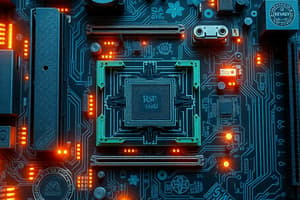Podcast
Questions and Answers
What is the primary function of the chipset on a motherboard?
What is the primary function of the chipset on a motherboard?
- To install expansion cards
- To provide power to components
- To increase system memory
- To manage data transfer and provide connectivity options (correct)
What is the most common form factor of motherboards used in desktop computers?
What is the most common form factor of motherboards used in desktop computers?
- Micro-ATX
- ITX
- Mini-ITX
- ATX (correct)
What type of ports allow connection of peripherals, such as keyboards and mice?
What type of ports allow connection of peripherals, such as keyboards and mice?
- USB Ports (correct)
- VGA/DVI/HDMI Ports
- Audio Jacks
- Ethernet Ports
What is the purpose of the BIOS on a motherboard?
What is the purpose of the BIOS on a motherboard?
What is the smallest form factor of motherboards used in compact systems and embedded devices?
What is the smallest form factor of motherboards used in compact systems and embedded devices?
What is the purpose of the memory (RAM) slots on a motherboard?
What is the purpose of the memory (RAM) slots on a motherboard?
What is the main component that connects and supports various components of a computer?
What is the main component that connects and supports various components of a computer?
Which part of a motherboard is responsible for controlling the flow of data between components?
Which part of a motherboard is responsible for controlling the flow of data between components?
What is the function of the peripherals connected to a motherboard?
What is the function of the peripherals connected to a motherboard?
What is the purpose of the jumper block on a motherboard?
What is the purpose of the jumper block on a motherboard?
What is the primary function of the SATA ports on a motherboard?
What is the primary function of the SATA ports on a motherboard?
Flashcards are hidden until you start studying
Study Notes
Components of a Motherboard
- CPU Socket: Where the CPU (Central Processing Unit) is installed.
- Chipset: Controls communication between components, manages data transfer, and provides connectivity options.
- Memory (RAM) Slots: Where RAM (Random Access Memory) modules are inserted to increase system memory.
- Expansion Slots: Allow installation of expansion cards, such as graphics cards, sound cards, and network cards.
- Storage Connectors: Connect storage devices, such as hard drives and solid-state drives.
- Power Connectors: Provide power to components, including the CPU, RAM, and storage devices.
Motherboard Form Factors
- ATX (305mm x 244mm): Most common form factor, suitable for most desktop computers.
- Micro-ATX (244mm x 244mm): Smaller than ATX, used in smaller systems and home theaters.
- Mini-ITX (170mm x 170mm): Smallest form factor, used in compact systems and embedded devices.
Motherboard Connectors and Ports
- USB Ports: Allow connection of peripherals, such as keyboards, mice, and flash drives.
- Audio Jacks: Provide audio output and microphone input.
- Ethernet Port: Enables network connectivity.
- VGA/DVI/HDMI Ports: Allow connection of monitors and displays.
- Serial and Parallel Ports: Legacy ports, rarely used in modern systems.
Motherboard Features
- BIOS (Basic Input/Output System): Firmware that controls the motherboard's functionality and settings.
- UEFI (Unified Extensible Firmware Interface): A more advanced replacement for BIOS, offering improved performance and security.
- Overclocking: Allows users to adjust CPU and RAM settings for improved performance.
- Fan Controllers: Regulate fan speeds to optimize system cooling and noise levels.
Motherboard Components
- CPU Socket: Installs the Central Processing Unit (CPU)
- Chipset: Manages data transfer, communication, and connectivity between components
- Memory (RAM) Slots: Holds RAM modules to increase system memory
- Expansion Slots: Installs expansion cards (e.g., graphics, sound, and network cards)
- Storage Connectors: Connects storage devices (e.g., hard drives and solid-state drives)
- Power Connectors: Provides power to components (e.g., CPU, RAM, and storage devices)
Motherboard Form Factors
- ATX: Most common form factor (305mm x 244mm), suitable for most desktop computers
- Micro-ATX: Smaller than ATX (244mm x 244mm), used in smaller systems and home theaters
- Mini-ITX: Smallest form factor (170mm x 170mm), used in compact systems and embedded devices
Motherboard Connectors and Ports
- USB Ports: Connects peripherals (e.g., keyboards, mice, and flash drives)
- Audio Jacks: Provides audio output and microphone input
- Ethernet Port: Enables network connectivity
- VGA/DVI/HDMI Ports: Connects monitors and displays
- Serial and Parallel Ports: Legacy ports, rarely used in modern systems
Motherboard Features
- BIOS (Basic Input/Output System): Firmware controlling motherboard functionality and settings
- UEFI (Unified Extensible Firmware Interface): Advanced replacement for BIOS, offering improved performance and security
- Overclocking: Adjusts CPU and RAM settings for improved performance
- Fan Controllers: Regulates fan speeds for optimized system cooling and noise levels
Computer Motherboard
- The main circuit board of a computer that connects and supports all hardware components together
- Acts as a communication highway, allowing components to exchange data and instructions
- Typically made of a sturdy, non-conductive material, such as fiberglass, to prevent electrical shorts
- Mounted with sockets, slots, and connectors to accommodate various components, such as CPU, RAM, and storage devices
- Contains a range of integrated circuits, including the chipset, which controls data transfer between components
- Often has a BIOS (Basic Input/Output System) or UEFI (Unified Extensible Firmware Interface) firmware to configure and boot the computer
- Power supply unit (PSU) connects to the motherboard to provide power to all components
- May feature additional components, such as capacitors, resistors, and inductors, to regulate power and signal flow
Studying That Suits You
Use AI to generate personalized quizzes and flashcards to suit your learning preferences.



